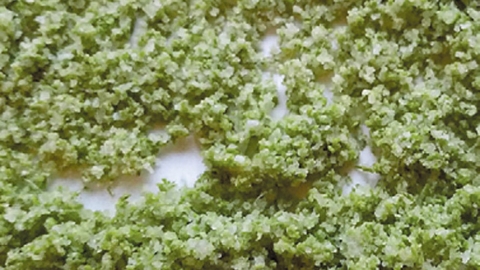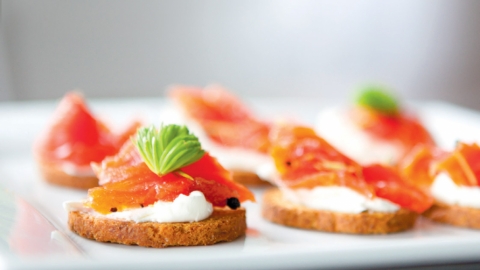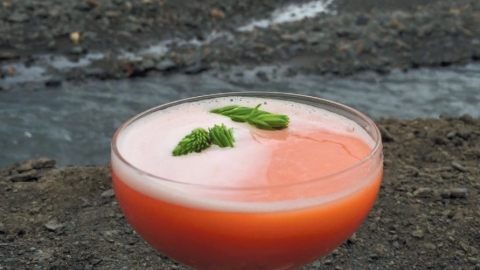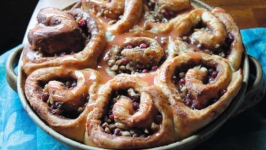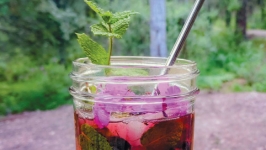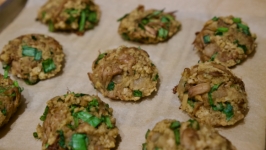Tip Off The Old Spruce
Around Southcentral and Southeast Alaska, spruce tips appear pretty reliably around Mother’s Day. Poet Seamus Heaney even referenced the bright fresh color, describing the “May-green spruce,” in his Glanmore Sonnets. The one exception I’ve noted to the May rule was the time I left our fresh Christmas tree up extra long because it still seemed so healthy and it was brightening our house during the still-dark days of post-Christmas winter. That year, sometime in late January, or early February (I know, I know), I got ready to take the thing down, and I noticed the bright green tips had pushed through their papery skins. Next year, I plan to try and force some tips with just a couple of spruce branches in a jar during the winter.
Spruce tips are what I think of as a “gateway” wild food—easy to pick, beginner friendly, and completely non-toxic. Spruce tips have a range of flavors depending on their stage of maturity: herbal, fruity, citrus, resinous. They play well with both sweet and savory dishes. All spruce varieties (from the pine or Pinaceae family) are edible. Janice Schofield, in Discovering Wild Plants, tells us that many parts of the tree have been historically used for food—from the new tips, to seeds from the cones, to the inner bark (cambium). Spruce tips have a long history outside of Alaska as an ingredient in spruce beer, and Captain Cook famously served the beer to sailors to ward off scurvy.
In Alaska, the use of spruce tips has grown well beyond home cooks, foragers, and home brewers. Many breweries around the state have adopted spruce tips in their recipes. Curtis Holmes of Alaskan Brewing told the Anchorage Press last year that the company uses 2,000–3,000 pounds of tips per year making their Spruce IPA.
Spruce trees are easy to identify. Spruce branches are sharp and pointy, unlike their hemlock neighbors, which are also edible. (Notably, yew trees in all varieties are extremely toxic, so if you’re foraging for conifers, make sure you can identify them. Unlike spruce, they have flat needles that come to a point at the end. In Alaska, yew occur only in Southeast.)
The tips first appear wrapped in a brown “paper” skin. The moment the tips begin to pop through the paper, they are ready to pick. There is a sweet spot in their growth cycle when they have mostly emerged but are still small. That’s the perfect time for picking. Too early, the tips encased in paper are a lot of extra work in the kitchen (the paper is resinous and not as tasty as the bright green tips). Too late and the tips’ flavor changes. They go from fruity and floral to tart and a bit medicinal. Next, they darken and become spruce branches, which are too tough and fibrous to eat.
Tip transformation happens quickly in May’s light-filled days. But if it seems like you missed it, try hiking up a hill. Forage on higher ground to find edible plants past their prime down low.
The word “spruce” came to the English language in medieval times. It was a shortening of the word “Prussia,” and it referred to the tree which was called Prussian fir. Prussians were considered orderly and tidy folks, and the term “to spruce up” also stemmed from the same origin. Spring cleaning and spring edibles—an unlikely connection!
I was introduced to spruce tips as a source for sweet treats, especially spruce tip syrup or jelly. It turns out that the tips have great savory uses as well. One of my favorite condiments to make is spruce tip salt. I find this salt is best used within a few months, because it loses flavor and color. So to have some in the winter, I make it again as needed with frozen spruce tips. Spruce tip salt is amazing on fresh salmon, or as a sprinkle on fresh spring salads, or on fresh tomatoes in summer. Erica Thompson Clark, who first turned me on to spruce tips, adds them to a glaze of mayo and whole grain mustard, which she coats on halibut and cod before grilling.
One of my favorite spruce items to have on hand is actually a byproduct of spruce tip syrup. After making a light syrup, I strain the tips and then dry the sugar-soaked tips in a dehydrator or in the oven. When they’re completely dried, they can be stored indefinitely (unlike the salt, they don’t seem to lose their flavor over time). Grind the tips as needed for spruce sugar topping on cookies, or to use in shortbread, or to rim a spruce-y cocktail (like the Currant Mood from Carissa Pearce in this issue). Many folks in Cordova like to make a much darker spruce tip syrup. The light syrup has much more of a fresh, herbal flavor, and I love it in cocktails. The amber syrup takes on the bright citrus notes of the spruce tips, and it’s great on pancakes.
Alaskan poet and writer Vivian Faith Prescott has become a little obsessed with spruce tips lately. She and her daughter Vivian Mork Yéilk’ are working together on a new book of spruce tip recipes. Prescott says, “I’ve eaten spruce tips since I was a child. I think that’s typical for people who are born and raised in Southeast Alaska. I’m pretty sure my parents and grandparents ate them in the spring. I’ve eaten them raw as a spring treat all my life and made spruce tip jelly and shortbread cookies when my children were young.”
Prescott’s forthcoming book is called Eat Your Trees, and it will feature many of her favorite recipes. I asked her what spruce tip advice she had to share. She says, “We have a section in our book called Spruce Tip Tips. One of the best tips I have is to know your spruce tip palate: experiment with the amount of chopped spruce tips you like in your recipes and write it down and stick with that. For example, one tablespoon might be too spruce-y for your tastes. One teaspoon might be just right. Also, it’s best to use fresh spruce tips, but when you can’t, and you’re using frozen ones, remember to chop them while frozen.” Vivian uses frozen tips all the time, she says. “I haven’t come across a recipe yet where I can’t use frozen spruce tips. Frozen spruce tips have about a year to two years’, thereabouts, freezer life. Basically, if the spruce tips in the freezer are starting to dull or yellow in color then they’re stale, so it’s time to make them into mulch for the garden.”
Originally published in Edible Alaska issue12, Summer 2019.






